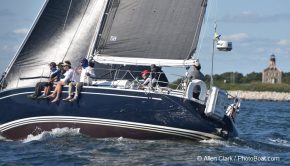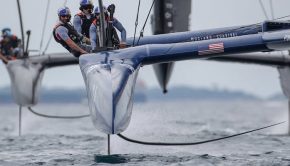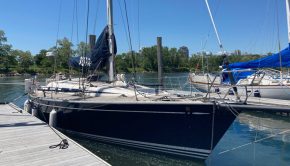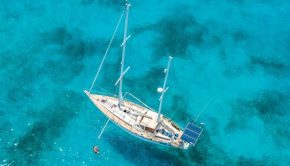Spinnaker = faster than genoa
Published on May 3rd, 2021
In this report by Tim Zimmermann, he shares how the Chesapeake confounds (again), but losing is winning (really), during the Annapolis NOOD Doublehanded race.
On Saturday, Rich Hoyer and I set out to race against 9 other boats registered for the North Sails Doublehanded Race (a new, and extremely welcome, feature of Sailing World’s NOOD regattas). Before kids, I used to race a J-22 every year in the Annapolis NOOD, and it is a great regatta and start to the local sailing season. So I was very excited to get back into it, in a new sailing discipline, with a good co-skipper. I had hopes.
Unfortunately, hopes are just hopes, and weather rarely defers to them. Mid-Atlantic Spring weather is rarely stable (as we already knew from the gale warning which cancelled one Wednesday Night Race, and the On/Off breeze which decimated last Wednesday’s racing).
To continue the theme, Friday’s NOOD one-design racing was cancelled by yet another gale warning, and gusts into the 50s and 60s. And our forecast for Saturday was exciting, but complex: WNW winds at 20, gusting 25-plus, at the start; then easing and backing throughout the day. Oh, and a building ebb current.
This presented a few conundrums. First, how much to tighten the rig before the race above the base 8-12 knot setting. For doublehanded sailing and no weight on the rail everything needs to be a little tighter than the tuning guide (or at least that is my theory). So I wanted to go tighter than base, but not so tight I would have no ability to power up when and if the wind got lighter. I opted to add two turns to the uppers and lowers. If it felt right, I could update my personal tuning guide. If not, I’d note that too. This is not a science (yet), but I like to pretend it is.
The next conundrum was whether to start with single or even double reef in the mainsail. Again, I am still learning what works best, and my current belief is that a reefed main and full genoa is preferable to a partially furled genoa (especially upwind). When we got to the start line off Hackett Point, it was…blowing. Regularly 20-plus, with solid, shifty gusts rolling off the land. A double-reef in the main seemed prudent until we knew what the race course would be.
At 10:30 the Race Committee, which was bobbing around trying to hold station as they were buffeted by wind and wave, and couldn’t get the anchor to hold, set the course. A downwind start to a channel marker across the Bay, then a reach south to another channel marker, then an upwind(ish) leg to a buoy off Thomas Point, another reach across the Bay to the first mark, and then upwind back to the finish. This changed our calculations. Since we would be off the wind for the first few legs, a double reef in the main was too conservative. Ten minutes before the start I scrambled to take the reef out and we went to a single reef.
The rest of the fleet seemed split. A number of boats had full main, and some also had a reef in. This was my first doublehanded race with Rich, so a reefed main seemed about right. A wipeout or any other mistake due to being overpowered and still figuring things out would probably cost us more time than the single reef. Or so we figured.
The next call we had to make before the start was whether to fly a spinnaker, and if we did which spinnaker to fly. It was obvious that any boat that successfully carried a spinnaker to the first mark (probably one gybe would be required) would make out. And any boat that tried and ended up in a mess would lose out. The call on board Moondust was slightly complicated by the spinnaker options. I have a .5-ounce symmetrical chute (which I figure can handle up to 15 knots of apparent wind).
And I know also have the .6 ounce asymmetrical chute which we flew for the first time last Wednesday, which I believe can handle more wind). However, the asymmetrical is not ideal for a dead downwind run, and it is also clear that it is best flown off the spinnaker pole (to keep the tack line clear of the bow pulpit). And gybing it with the pole in heavy winds promised to be an adventure.
In short, we didn’t have the ideal downwind sail (a .75-ounce symmetrical would have been great). So we decided to (conservatively) run with main and genoa to the first mark, which was about 5 miles downwind, figuring we would be near hull speed anyhow. Distracted by all these considerations and possibilities I was then about 5 seconds late for the start. Few boats were right on the line, for some reason. But that is no excuse. Just screwed up the timing.
At the start of the run, all the choices different boats made (and the consequences) were quickly revealed. Mike Beasley, in his GP26 Rattle N Rum, shot off toward the Eastern Shore under main and spinnaker, and never looked back (winning the race easily). Pat and Amy Teeling, on their Person Flyer Blaze Star, which they have been sailing together for 20 years, carried full main and launched their spinnaker. They were the second-slowest rated boat in the fleet, and their sail choice kept them well ahead of us and a handful of other boats to the first mark. That is how to begin a solid performance.
One or two other boats carried spinnakers. I didn’t see anyone broach or sail themselves into a costly clusterfu*ck. We tried to sail wing and wing. The puffs and swell made it hard to keep the jib full, and things were so fine we accidentally gybed the main a few times. We were sailing at 7 or 8-plus knots a lot of the time.
Still, it felt slow. Using the pole with the jib definitely would have improved things. But the first and immediate lesson of the race was obvious to all soon after the start: fly the damn spinnaker, and a full main, instead of whimpering about sailing in big breeze downwind. Sometimes you can only learn by actually doing. Even if you crash and burn. Or maybe especially if you crash and burn.
We finally got to the first mark, with some other boats around us (a few owed us time so we were at least in the mix), and hardened up into a reach. The wind had eased a bit, but it was still steady teens and we were flying along. I could see the distance to Blaze Star start to close. A few boats fell behind. It was another 8 miles to the next mark, and as the wind kept dropping little by little, though it stayed on the beam, we shook the reef out of the main and launched the asymmetrical spinnaker, tacked to the bow.
All the boathandling was really smooth, which made me happy (plus we learned a better lead for the spinnaker tack line), and we continued to close on the cluster of boats in front of us. Things felt so good that Rich joyfully tucked into a heap of sardines for lunch while I tried to remain upwind.
Unfortunately, as the wind got even lighter, down to 8-10 knots or even less, our speed advantage over Blaze Star on this wind angle diminished (Blaze’s white hull was easy to pick out, so a good marker). Still, by the time we got to the mark she was just inside us, and some sense of order was returning to the planet. We doused early (probably too early, but we are learning…) and prepared for upwind mode.
The plan was simple: with a strong ebb, and the wind forecast to go left as it kept dying we wanted to position ourselves to the left of the fleet going back upwind toward Thomas Point. We tacked briefly onto port just after the mark to clear our air, and then flipped back onto starboard to head toward the Western Shore. Most of the boats in our vicinity around the mark started to come back north, which made it easy for us to cross their tracks and establish ourselves on the left.
As soon as we saw some header, we tacked back onto port to head north, placed just where we wanted to be relative to the fleet around us. Rich got on the helm while I jumped around tweaking everything for speed.
It was our best leg. We stayed to the left of everyone, gaining (hopefully) from less current and (definitely) from a slow and persistent left shift. We started to stretch out ahead of Blaze and the others, and grind down a slightly faster Grand Soleil 34, Ted Ruegg’s Grand Plan, that had been well ahead of us at the previous mark.
Holding our lane just above them, to stay out of their dirty air, forced us to stay fully concentrated and sail fast and well. We learned a lot about how to best trim the main, which had been a slight puzzle for me since I got it last year. Everything felt in synch. The sun was out. The sky was blue. The breeze hadn’t died. And Moondust is a true pleasure to drive to windward in those conditions. Rich and I were both smiling. It was very hard to think of a better place to be.
About a mile from Thomas Point, the Grand Soleil suddenly pointed higher and elevated effortlessly to windward of us, wiping out our beautiful clean lane. I’m not sure whether it was a slight change in the breeze strength that unlocked the added height for them, or whether they had suddenly found a better trim setting, but whatever it was I was grateful they hadn’t found it earlier.
By now the wind had backed enough that we were easily laying the mark just south of Thomas Point, so we could live in their disturbed air for a few minutes without any stress. As we rounded the mark, leaving it to starboard, I looked back. Blaze Star and the others we had passed going upwind were well astern. It was hard to say how far, but maybe a mile or more. Whatever it was we had made a really nice gain, and perhaps we were back in it.
The next leg turned out to be the last leg. With the breeze continuing to go light, and 3 pm fast approaching, the Race Committee shortened the course to finish at the next mark (I love Race Committees that pay attention and shorten the course when it is appropriate). We were on another close reach, and now the wind was going very soft. Ahead, I could see that the fastest boats—Rattle N Rum, Zuul (an Aerodyne 38), and Windborn ( a J-120)—were finishing or had finished.
Behind, I could see the rest of our fleet rounding the mark at Thomas Point. Both Moondust and Grand Plan were all alone between them, doing everything we could to get to the finish as fast as possible against the ebb, and with wind holes forming all around us.
On the plus side, Rich and I steered, trimmed, and crawled our way past the Grand Soleil. On the minus side, as our speed slowed to around 1 knot I could see Blaze Star and the rest of the pack we had distanced still pressed over and a breeze line literally advancing toward us with them.
That is a discouraging, possibly infuriating, sight. It requires a philosophical frame of mind, and acknowledgement that on the Chesapeake Bay there are many things you can’t control. I tried not to think about the fact that if we had flown a spinnaker the first leg we probably would have gained 5-10 minutes, and likely would have finished before the big wind dropout now miring us in agony.
It was easy to see how this was going to end. All Rich and I could do was try something different. The breeze finally steadied up again at perhaps 4 knots. The apparent wind was forward of the beam. The small gap that remained between us, Grand Plan (50 meters back), and then Blaze Star and the others (maybe a few hundred meters back,) was no longer shrinking. But we had a mile to go and we needed that gap to expand. We threw up the asymmetrical again to see what would happen. If we couldn’t carry it or had to douse it immediately, well, at least we tried. Of course we hoped it might change the game. And it did. Sort of.
The first important insight was that we could carry it at an apparent wind well below 90 degrees. In fact, just before the finish a fishing boat with troll lines insisted on crossing just ahead of us and forced us to luff up to stay clear of his lines. It was annoying, but also revealed that, strapped tight, the asymmetrical could be carried at 40-50 degrees apparent wind. Whether that would be faster at that angle, I don’t know.
But it definitely felt, and seemed, a little faster at 60-70 degrees apparent when we were on our correct course. The gap to the Grand Soleil and the others started opening. Not by the huge increments we needed at that point (one can dream). But enough that we now know there is a light wind Code 0 mode for that sail. That’s good info that I am glad to have.
We crossed the finish and doused the asymmetrical. The others crossed minutes later. In the end, we came 7th out of 9 boats on the water (1 boat stayed home). Rattle N Rum crushed the fleet, with a corrected time that was 21 minutes faster than the BC27 in second place. Windborn, the J-120, was four minutes slower on corrected than the BC27. And our friends on Blaze Star corrected out just two minutes slower than Windborn.
With all the reaching it is no surprise that the top three boats were reach-loving asymmetric boats. In some ways, the performance of the day, in my mind, went to Blaze Star, which is far from a sprit or sport-boat design, yet came close to cracking the top 3. Moondust was almost 15 minutes behind Blaze Star on corrected time. Chapeau.
Now let’s play some mental games (you have to have some fun with handicap racing). Believe it or not, I can almost find 10-15 minutes easily in my head. How? Start by figuring a spinnaker and full main on the first leg might have gained us 5-plus minutes to the first mark (entirely our own fault). Next, consider that the painful wind hole on the final leg, which trapped Moondust and Grand Plan while others continued to advance, probably cost us another 5-plus minutes (Chesapeake wind gods sailing tax; not really our fault).
And, finally, finish it off with my own personal Handicap Racing Multiplier Effect Theory (HRMET, trademark coming), in which any minutes saved (MS) in a race with a dying breeze translates into finishing more than MS minutes faster. Why? Because the less time you are on a course in a dying breeze the higher the average wind speed you sailed to complete the course (if the wind stays at exactly the same strength throughout a race a minute saved or lost at any point is a minute saved or lost at the finish).
And the earlier you save those minutes in a dying breeze, the greater the percentage of the race you are sailing in higher wind speeds, and the greater the bump to your average wind speed sailed (so the higher the multiplier effect). According to this highly-serious, carefully-calculated law of handicap sailboat racing, the 5-plus minutes we lost on the first leg by chickening out on a spinnaker cost us perhaps 10 minutes overall.
Side note: I admit that this may sound confusing. It may be because I am not explaining it well (likely). Or that is it total self-serving BS (possible). Regardless, if you buy me a beer next time you see me I will try and make it all crystal clear (might take more than one beer).
Put all those factors together, and, voila, we could have had a good race! Or so I tell myself. But kinda, sorta, not really. In reality, you can rationalize and do all the mental gymnastics you want with regard to handicap racing. At some point you have to put up a result. And in this case, we seriously compromised our chances of doing that with our sail plan decisions on the first leg, which is entirely on me.
There’s no way around that one, but it was a spectacular day on the water, and I am very content with how we handled the boat and the choices we made during the rest of the race. Every time we go out and line up against other boats we learn more about what works on Moondust, and what doesn’t. And we climb the learning curve.
Eventually (hopefully sooner rather than later), we’ll figure the boat out (the Bay itself, I am not so sure), and get better and smarter. Of course, there are a lot of really good sailors in Annapolis, so you have to get plenty good and plenty smart to finish well. But if it was easy, it wouldn’t be fun.
Before signing off, I can’t resist sharing Annapolis sailor Eric Peltosalo’s summary, in Scuttlebutt, of his numerous responsibilities as Pit person a local Annapolis race boat.
All I can say is: Is Eric for real or are we being pranked? If real, what lucky SOB has Eric sailing with him (and I hope Eric gets free use of any second homes and high end cars)? Who is Eric and what factors in his life produced the world’s most helpful Pit person?









 We’ll keep your information safe.
We’ll keep your information safe.